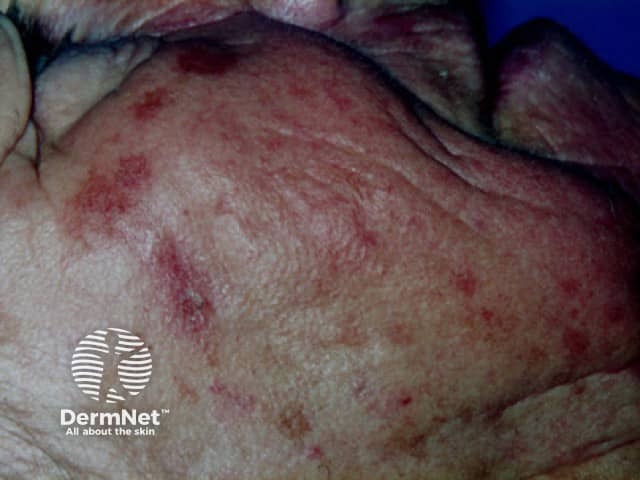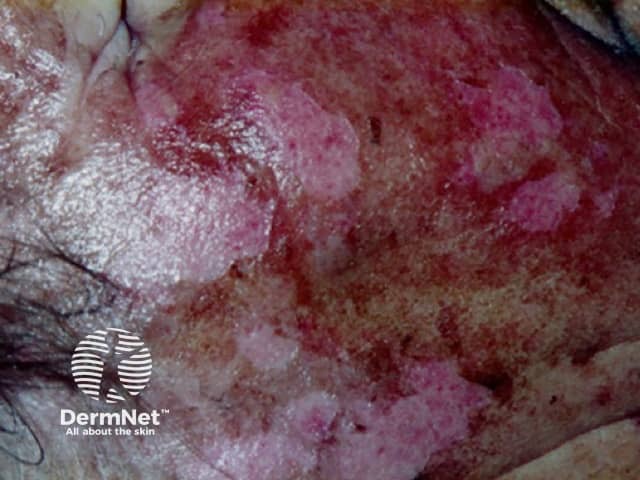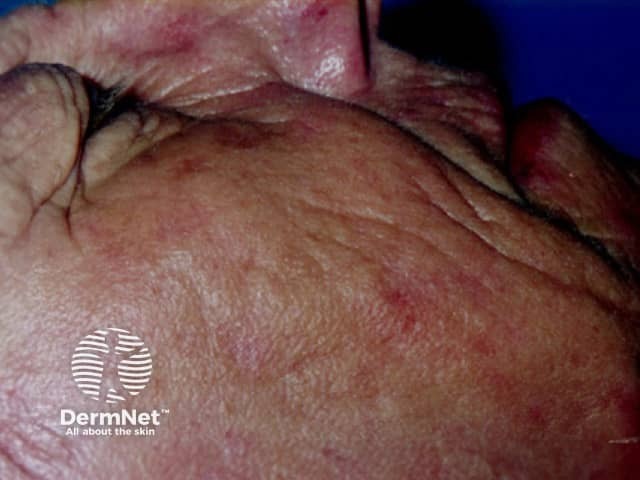Main menu
Common skin conditions

NEWS
Join DermNet PRO
Read more
Quick links
Chemical peels — extra information
Chemical peels
Author: Hon A/Prof Amanda Oakley, Dermatologist, Hamilton, New Zealand, 1998. Updated by Dr Ebtisam Elghblawi, Dermatologist, Tripoli, Libya. DermNet Editor in Chief: A/Prof Amanda Oakley, Dermatologist, Hamilton, New Zealand. October 2018.
Introduction How it works Indications Contraindications Types Before the peel The peel procedure After the peel Skin care post-peel Complications General advice
What is a chemical peel?
A chemical peel refers to the application of one or more chemicals to the skin which 'burn' off damaged cells, resurfacing the skin.
The three principal types of chemical peels are alpha-hydroxy acid peels, trichloroacetic acid peels, and the phenol-croton oil peel.

Pre-TCA

Peels

Peels
How does a peel work?
A peel removes several layers of sun-damaged skin cells, leaving fresh skin which has a more even surface and colour. It may stimulate new collagen to be formed improving the skin texture. Peels may result in superficial, moderate depth or deep skin injury.
What are the indications for a peel?
Chemical peels are most often used on the face, but they are sometimes applied to other sites such as the hands.
A peel may be used to treat damage caused by exposure to the sun (photoageing) including actinic keratoses, to remove pigmentation such as freckles and melasma, to reduce fine lines and wrinkles, and to improve acne.
They are most often used in patients with fair skin, Fitzpatrick skin types I to III.
Peels can be repeated as necessary; some people have superficial peels every few weeks. It is wise to wait for 3 to 6 months before repeating a moderate depth peel.
What are the contraindications to a chemical peel?
Patients with Fitzpatrick skin types IV to VI have increased risk of dyspigmentation, hypertrophic, and keloid scarring and chemical peels must be performed cautiously with full patient informed consent.
Types of chemical peel
Superficial peel
Superficial peels use glycolic acid, salicylic acid and Jessner solution and are well tolerated — the 'lunchtime' peel. They remove thin lesions on the skin surface, reducing pigment and surface dryness. The result of the first peel may be disappointing, but after repeated peels, significant improvement is usually evident. A nurse or aesthetician (beauty therapist) may perform superficial peels.
Medium depth peel
Trichloroacetic acid (TCA) is the most common chemical used for a medium depth peel. The results depend on its concentration, usually 20–35%. The treatment is painful and treated areas are swollen, red and crusted for the next week or so. It can lead to an impressive improvement in skin texture with a reduction in blotchy pigmentation, freckling and actinic keratoses (dry sunspots). Although fine wrinkles and some acne scars are less obvious, the TCA peel has no effect on deep furrows. A dermatologist or plastic surgeon usually performs moderate to deeper peels.
Deep peel
Phenol results in deep skin injury. It is rarely used for facial peels nowadays because of the risk of scarring and because of its toxicity. Absorption of phenol through the skin results in potentially fatal heart rhythm disturbances and nerve damage. However, it is very effective at improving both surface wrinkles and deep furrows. After a phenol peel, the treated skin is pale and smooth but it may be waxy and 'mask-like'.
Before the peel
A chemical peel is a four-step procedure:
- Pre-peel preparation
- Peeling procedure
- Recovery phase
- Maintenance phase.
The performance of a peel requires a thorough knowledge of aesthetics including any medical or surgical treatment for skin ageing.
Determine whether the peel is required for a focal lesion or for the entire face. Undertake a pre-peel classification.
- Fitzpatrick skin phototype: lighter peels are undertaken in darker skin because of the risk of postinflammatory pigmentation
- Previous experience of skin peels
- A tendency for the skin to develop increased and/or loss of pigmentation at the sites of skin injury
Pre-treatment creams are applied to the face at night for several weeks prior to the peel. By exfoliating the skin and reducing pigmentation themselves, they improve the results seen from chemical peeling. They may also reduce the time needed for healing. The creams usually include one or more of the following:
- Tretinoin
- Alpha hydroxy acid e.g. glycolic or lactic acid
- Hydroquinone for tanned or dark-skinned patients or those with melasma
Broad-spectrum SPF 50+ sunscreen should be used during the day.
The peel procedure
Superficial chemical peels are a minor procedure and no special arrangements are needed. But you may need painkillers, sedation, local anaesthetic or even a general anaesthetic for deeper peels.
First, the face is thoroughly washed to remove surface oil. The peeling agent is then applied for several minutes. It stings - how badly and for how long depends on the chemical, its concentration, whether you've had pre-treatment with aspirin, and individual factors. A fan can help. The peel is then neutralised, and the burning sensation lessens.
Individual treatments may include peels with several agents on the same occasion, with the aim of improving results and reducing risks.
Antibiotics and oral antiviral agents may be recommended after deeper peels.
What happens after the peel?
Superficial peels result in mild facial redness and occasional swelling which usually resolve within 48 hours. The peeling is similar to a sunburn. Most people can continue their normal activities. Make-up can be applied a few hours after the procedure.
Moderate depth peels result in intense inflammation and swelling, which resolve within a week. The peeling is more marked. Mild redness can persist for several weeks. Most people take a week off from work after a moderate depth peel.
Looking after the skin after the peel
- Keep treated areas cool (use a water spray).
- Do not pick! Picking delays healing and causes scarring
- Moisturise - use light preparations after a superficial peel, thicker moisturisers after a deeper peel
- Protect from the sun - especially for the first 6 months
- If advised to do so, continue to use tretinoin, glycolic acid and/or hydroquinone at night long-term
Complications of chemical peels
Complications are uncommon if the health professional performing the peel is properly trained and experienced.
- Comedones (blocked pores) or acne may result from the peel itself or from thick moisturisers used afterwards; ask your dermatologist for treatment.
- Infection due to bacteria (Staphylococcus aureus), yeast (Candida albicans), or virus (Herpes simplex); you may need antibiotics.
- Scarring may result from infection or picking the scabs, and can be permanent.
- Blotchy pigmentation is most likely in those with darker skin or who had a pigmentation problem before the peel; keep out of the sun and use hydroquinone.
- Persistent actinic keratoses may require treatment. Your dermatologist may choose cryotherapy, 5-fluorouracil cream or biopsy a lesion in case it is skin cancer.
General advice
- Ensure your doctor's instructions are carefully followed
- If you don't understand, ask!
- Let your doctor know promptly if there are any problems — complications are easier to deal with early than late.
References
- Fanous N, Zari S. Universal Trichloroacetic Acid Peel Technique for Light and Dark Skin. JAMA Facial Plast Surg. Published online January 12, 2017. doi:10.1001/jamafacial.2016.1666. Journal.
- Jackson A. Chemical peels. Facial Plast Surg. 2014 Feb;30(1):26-34. doi:
10.1055/s-0033-1364220. Epub 2014 Jan 31. PubMed PMID: 24488634.
On DermNet
Other websites
- Glycolic acid peel therapy – a current review — Jaishree Sharad, Clinical, Cosmetic and Investigational Dermatology, 11 November 2013
- Chemical peels — Medscape Reference
- Chemical peels — American Academy of Dermatology
